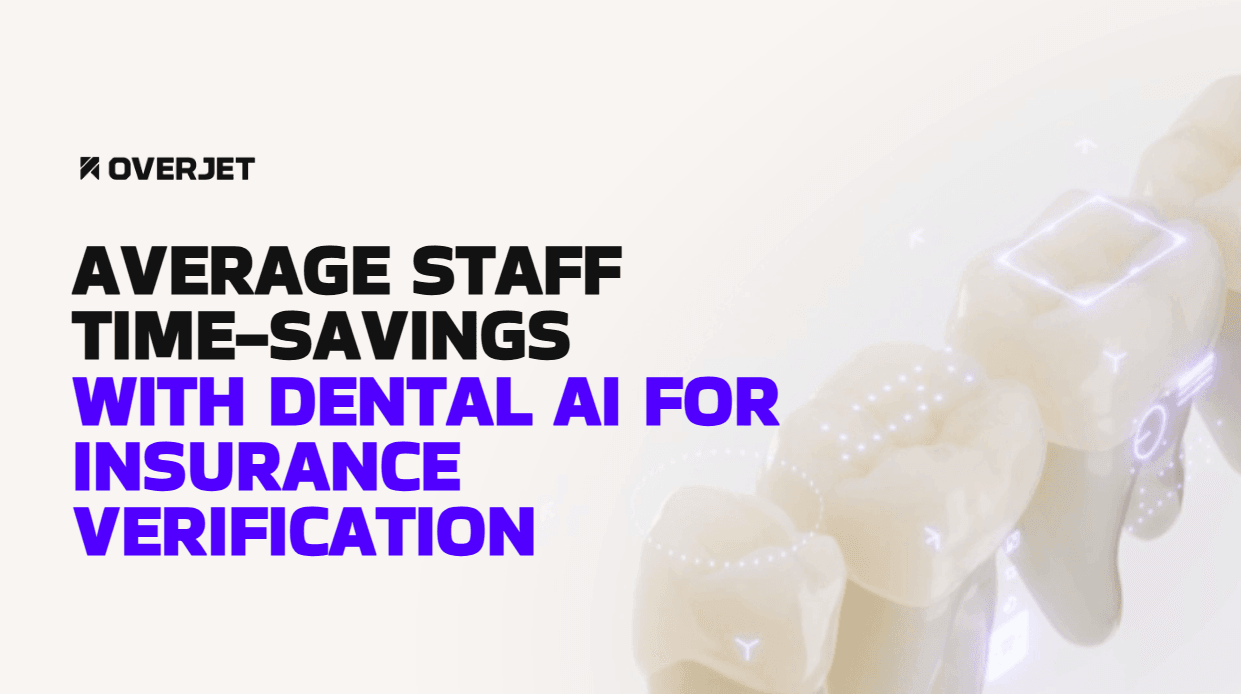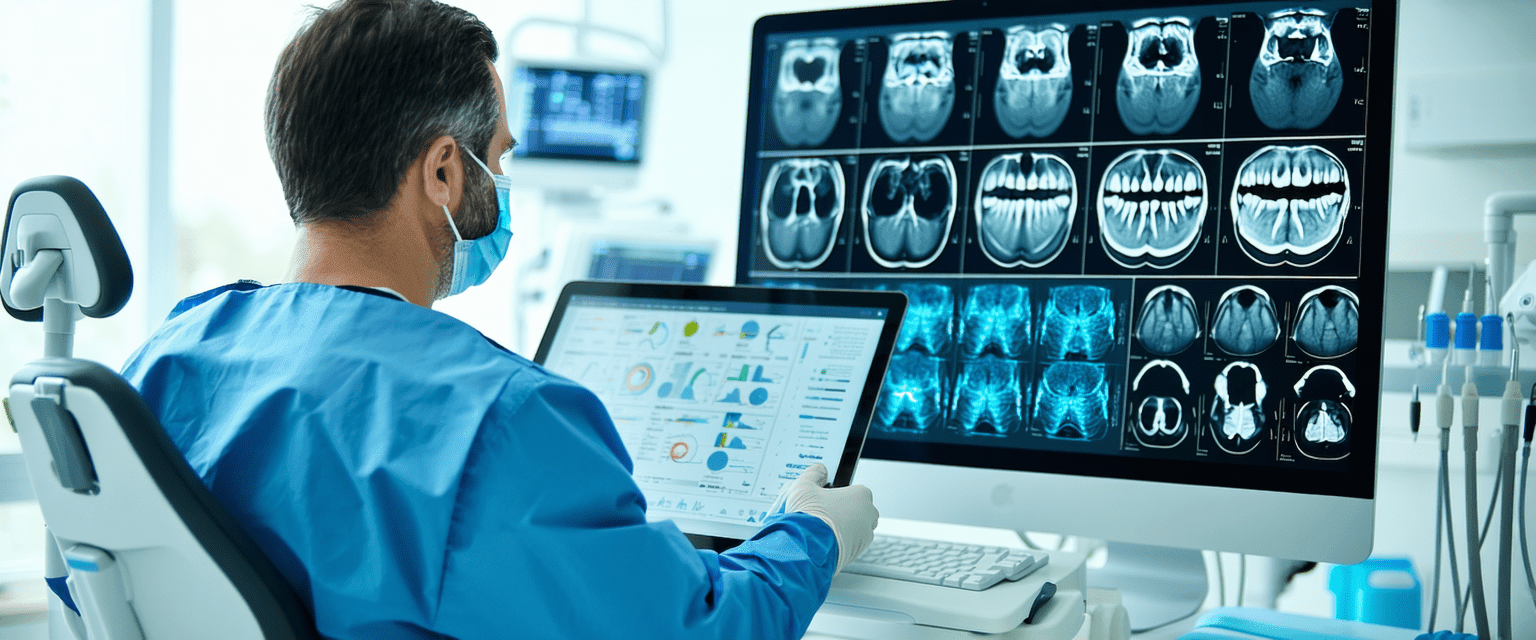In today’s dental practices, patient education is more critical than ever. Patients want to fully understand their diagnoses, feel confident in their treatment decisions, and trust that they’re receiving the best care. Yet, traditional methods—like plain radiographs, technical jargon, or complex charts—often leave patients feeling confused, overwhelmed, or unsure about recommended treatments.
That’s where AI-powered tools like Overjet Dental AI are changing the game. Overjet helps dental professionals simplify complex clinical data and turn it into clear, visual, and objective information that patients can easily understand.
Key ways Overjet AI empowers dentists to educate patients:
AI-annotated X-rays: Overjet highlights cavities, bone loss, and calculus using color-coded overlays and precise measurements, so patients can clearly see areas of concern.
Objective insights: The AI provides consistent, data-driven findings that build patient trust and eliminate uncertainty.
Simplified communication: With clear visuals, dentists can explain diagnoses and treatments without relying solely on technical terms or difficult-to-interpret images.
By providing these AI-powered tools, Overjet allows dentists to bridge the gap between diagnosis and patient understanding.
When patients can see exactly what’s happening in their mouths, they’re more likely to:
Feel informed and empowered in their care decisions.
Approve necessary treatments with confidence.
Build a stronger relationship with their dental care team.
Ultimately, Overjet Dental AI supports practices in delivering better patient experiences and improving oral health outcomes through enhanced education and trust.
Explore Overjet's Dental AI Software
What Is Dental AI and How Does It Work?
Dental artificial intelligence (AI) refers to the use of advanced technologies that support dentists in analyzing dental images, diagnosing conditions, and planning treatments more effectively. By combining machine learning and computer vision, dental AI enhances clinical workflows, improves diagnostic accuracy, and helps dental professionals deliver clearer, more consistent care.
A leading example of this technology is Overjet Dental AI. Overjet integrates directly with digital radiography systems and practice management software, working seamlessly in the background to process and interpret dental X-rays in real time.
Here’s how Overjet Dental AI works to support both dentists and patients:
Automatic detection of conditions: The AI scans X-rays for signs of common dental issues such as cavities, bone loss, and calculus, helping dentists identify problems at an early stage.
Precise quantification and annotation: Overjet highlights areas of concern with color-coded overlays and provides exact measurements—such as bone loss in millimeters—offering an objective and detailed view of the patient’s oral health.
Easy-to-understand reports: The software generates clear, annotated images and reports that help both dentists and patients visualize the diagnosis and understand the treatment plan.
By leveraging sophisticated machine learning algorithms, dental AI delivers accurate, objective, and consistent insights that complement a dentist’s clinical expertise. Rather than replacing the dentist’s judgment, Overjet AI acts as a valuable partner, enhancing patient communication, supporting evidence-based care, and ultimately helping patients feel more confident in their treatment decisions.
How AI Improves Patient Education
One of the most powerful ways AI enhances dental patient education is by transforming complex clinical data into clear, visual explanations that patients can easily understand. Dental conditions like cavities, bone loss, or calculus deposits are often difficult for patients to identify on traditional radiographs. Expecting patients to interpret subtle patterns or faint shadows can lead to confusion or hesitation when it comes to accepting treatment.
This is where Overjet Dental AI makes a significant impact. The platform uses artificial intelligence to generate annotated X-rays and 3D visualizations that highlight key issues in a patient’s mouth. These AI-powered visuals provide a level of clarity that traditional tools simply can’t match.
With Overjet AI, dentists can visually demonstrate:
Tooth decay (caries) — Clearly marking areas where cavities are present or developing.
Bone loss — Highlighting the extent of bone deterioration around teeth, complete with precise measurements.
Calculus deposits — Identifying hardened plaque that can contribute to gum disease.
Crown margins or overhangs — Pointing out areas where dental restorations may need attention.
These visual aids help patients see and understand what’s happening in their mouths, empowering them to make informed decisions about their care. When patients can clearly visualize conditions, they’re more likely to trust the diagnosis, ask meaningful questions, and move forward confidently with necessary treatments.
Ultimately, AI-supported education bridges the gap between diagnosis and understanding, improving communication and treatment acceptance.
Consistency and Objectivity in Findings
One of the key advantages of using Overjet Dental AI is the ability to deliver consistent, objective, and evidence-based findings. In traditional dental care, interpretations of X-rays and diagnoses can sometimes vary slightly between different practitioners or even between visits with the same provider. While dentists strive for accuracy, human interpretation can be influenced by subtle differences in training, experience, or even how the images are viewed.
Overjet’s AI technology helps minimize these variations by applying the same precise algorithms to every dental image. This means that diagnostic findings are standardized across the practice, ensuring that all patients receive a clear, consistent assessment of their oral health.
Here’s how Overjet Dental AI builds trust and transparency through consistency:
Objective measurements: The AI provides exact data points, such as millimeter-level measurements of bone loss or cavity size, giving patients clear proof of their condition.
Reliable follow-up: When patients return for future visits, the AI applies the same standards, making it easy to track changes over time and spot progress or new concerns.
Support for second opinions: Overjet’s annotated images and reports make it simpler for patients to seek additional input, as the findings are backed by consistent, AI-generated data rather than subjective interpretation.
By offering this level of objectivity, Overjet Dental AI strengthens patient confidence, encourages transparency, and supports better decision-making for both dentists and their patients.
Simplified Communication for Complex Cases
Dental conditions such as periodontal disease, malocclusions, and impacted teeth can be difficult for patients to fully understand. These complex cases often involve subtle anatomical details, long-term implications, and multi-step treatments that can overwhelm patients, especially when explained using only technical terminology or standard radiographs.
This is where Overjet Dental AI becomes an invaluable tool for enhancing communication. The platform uses artificial intelligence to create clear, easy-to-understand educational summaries that combine annotated visuals with simplified explanations. These AI-generated resources help patients grasp the nature of their conditions and the reasoning behind recommended treatments.
With Overjet AI, dental professionals can:
Tailor explanations to the patient’s knowledge level: Whether a patient is well-versed in dental terminology or new to these concepts, AI-supported visuals and summaries can be adjusted to meet their needs.
Use visuals and plain language to clarify risks and benefits: By highlighting key areas of concern on X-rays and providing straightforward explanations, dentists can make complex conditions feel more approachable and less intimidating.
Engage patients in co-planning their treatment: When patients better understand their diagnosis, they can ask informed questions, weigh their options, and take an active role in shaping their care plan.
Ultimately, Overjet Dental AI empowers practices to bridge communication gaps, fostering stronger patient relationships and encouraging higher treatment acceptance, even in complex cases.
AI’s Role in Improving Treatment Acceptance
A major factor in whether patients choose to move forward with recommended dental treatments is their ability to understand their condition and the benefits of intervention. When patients feel confident that they fully grasp what’s happening in their mouths—and why treatment is necessary—they are far more likely to approve the care their dentist recommends. This is where Overjet Dental AI plays a powerful role.
Overjet uses artificial intelligence to connect the dots between diagnosis and treatment in a way that’s clear, objective, and easy for patients to comprehend. The platform provides dentists with tools to visually and verbally guide patients through their care options, making the decision-making process less stressful and more collaborative.
Here’s how Overjet Dental AI helps improve treatment acceptance:
Direct link between diagnosis and treatment plan: AI-generated reports clearly show the problem areas and how each proposed treatment addresses them.
Before-and-after simulations: Patients can see projections of expected outcomes, helping them visualize the benefits of accepting care.
Data-driven clarity that reduces uncertainty: Instead of relying solely on verbal explanations, dentists can use AI visuals and measurements to provide evidence that supports their recommendations.
By providing this level of transparency and educational support, Overjet helps practices achieve higher case acceptance rates, greater patient satisfaction, and better long-term oral health outcomes. Patients feel more empowered, trust the process, and are more motivated to follow through with necessary care.
Applications Beyond the Dentist: AI for the Whole Dental Team
While dental AI is often seen as a tool primarily for dentists, its true value extends across the entire dental team. In a modern practice, patient education and communication are not limited to what happens in the dentist’s chair. Overjet Dental AI empowers hygienists, treatment coordinators, and office staff to play an active role in helping patients understand their oral health and make informed decisions.
By giving all team members access to AI-generated visuals and reports, Overjet ensures that educational messages are consistent, accurate, and easy for patients to follow, no matter who they’re speaking with.
Ways the whole dental team can leverage Overjet AI:
Hygienists can reinforce educational points during cleanings and maintenance visits, using annotated X-rays to remind patients about areas of concern or progress made.
Treatment coordinators can guide patients through their X-rays during consultations, helping them understand how proposed treatments align with their diagnosis.
Office staff can confidently answer questions by referencing AI-supported data, reducing ambiguity and building trust even during phone calls or follow-up discussions.
This collaborative, AI-powered approach ensures that patient education is consistent and comprehensive at every touchpoint. When the entire team uses the same objective data and visuals, patients receive clear, unified messages that enhance understanding, reduce confusion, and encourage treatment acceptance.
Ultimately, Overjet helps transform dental practices into cohesive, patient-centered teams working together to deliver outstanding care.
Best Practices for Using Dental AI in Patient Education
To get the most out of Overjet Dental AI and ensure patients fully benefit from AI-powered insights, it’s important for dental practices to approach patient education thoughtfully and consistently. Dental AI is most effective when it becomes an integrated part of your communication strategy, not just an occasional add-on.
Here are some best practices for using dental AI to enhance patient education and support treatment acceptance:
Incorporate AI visuals into every consultation. Make it standard practice to review annotated X-rays or AI-generated reports with patients during exams and consultations. Consistent use of visuals helps patients better understand their oral health and builds trust over time.
Train your entire team. Ensure that dentists, hygienists, treatment coordinators, and front office staff are comfortable interpreting and explaining AI findings. A well-trained team can provide consistent messaging and confidently address patient questions.
Be transparent about AI’s role. Let patients know that AI is there to support your expertise, not replace it. Emphasizing that AI provides objective data while the dentist makes the final clinical decisions reassures patients and builds confidence in your recommendations.
Encourage questions and dialogue. Use AI visuals as conversation starters. Invite patients to ask about what they’re seeing and express any concerns, turning the consultation into a collaborative, educational experience.
By following these best practices, dental teams can create a patient-centered, AI-supported environment that fosters understanding, trust, and higher treatment acceptance.
The Future of AI in Dental Patient Education
The use of artificial intelligence in dentistry is evolving rapidly, and its role in patient education is only just beginning. As dental AI technology continues to advance, we can expect even more innovative tools that make it easier for patients to understand their oral health, engage in their care, and make confident treatment decisions.
Here are a few exciting developments on the horizon:
More personalized educational content: Future dental AI systems will likely generate tailored educational materials for each patient. This could include interactive apps, custom AI-generated videos, and digital guides that address specific conditions, treatment plans, and risk factors unique to the individual.
Enhanced predictive analytics: AI will not only help patients understand their current oral health status but also forecast future outcomes. Using historical and real-time data, AI could show patients their likely oral health trajectory, illustrating how conditions may progress with or without treatment, and helping motivate preventive action.
Greater integration with teledentistry: As virtual care becomes more common, AI tools will play a bigger role in remote consultations and education. Patients could review annotated X-rays, receive interactive explanations, and discuss treatment options with their dental team, all from the comfort of home.
Ultimately, the future of dental AI will focus on empowering patients with clearer information, more personalized guidance, and greater access to care, making patient education an integral part of modern, technology-enhanced dentistry.
Dental AI is Here
Overjet Dental AI is more than just a diagnostic tool—it’s a powerful ally in educating and empowering dental patients. By turning complex data into clear, visual, and objective insights, Overjet helps dental professionals build trust, improve communication, and increase treatment acceptance. Adopting AI tools today positions your practice at the forefront of patient-centered care.
Ready to See Overjet's Dental AI in Action?
FAQs - Dental Patient Education with AI
How does Overjet Dental AI help patients understand their X-rays?
Overjet provides annotated radiographs that highlight decay, bone loss, and other conditions using colors and measurements, making it easier for patients to see and understand their oral health.
Can AI help improve treatment acceptance?
Yes. AI-supported visuals and objective data help patients see the need for treatment, reducing uncertainty and increasing their confidence in approving care.
Does AI replace the dentist’s expertise?
No. AI is a tool that supports the dentist’s judgment by providing objective insights and visual aids. The dentist remains the ultimate decision-maker.
Is AI useful for the entire dental team?
Absolutely. Dental hygienists, coordinators, and office staff can all use AI visuals to help educate patients and reinforce treatment recommendations.









